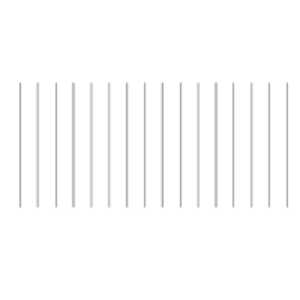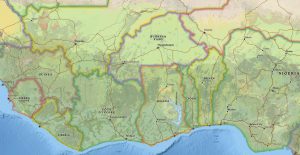
Olivier Walther, University of Florida
Steven M Radil, US Air Force Academy
Alexander Thurston, University of Cincinnati
Abdul Zanya Salifu, University of Calgary
16 August 2023
The jihadist groups that have laid waste to the Sahel over the past decade are creeping along the southern borders of Mali and Burkina Faso. How far south will they go? Without making a moral equivalence between the past and the present, this short essay discusses how historical, cultural and political factors could shape the new geography of armed conflict in the region. It suggests that the southern expansion of jihadist groups will ultimately depend on the timely and appropriate set of initiatives taken by coastal countries.
In the past 20 years, jihadist groups affiliated with Al Qaeda and the Islamic State have been successful in expanding across the Sahel due to speed, range and endurance. Their ability to move rapidly without the logistical constraints of regular troops have made them extremely difficult to counter militarily, especially in regions that cannot be controlled from fortified posts. Jihadist groups have managed to build strong bases in border, mountainous or remote regions, from which they can recruit and train their members and skilfully exploit local grievances.
In the Central Sahel, the spatial cluster of violence subsumes nearly all the borderlands along the Mali-Burkina Faso-Niger border, from Sikasso in the west to the W National Park in the east (Map 1). Taken together, these regions represent a conflict belt approximately 1 200 kilometres long and 200 kilometres wide, in which jihadist groups have managed to build on the support of the population – whether empathetic to their cause or coerced – to provide intelligence on the enemy, as the Tongo-Tongo ambush against a patrol of Nigerien and US soldiers in 2017 demonstrates. This combination of mobility, superior intelligence and ruthless violence has led to unprecedented levels of political violence in the Sahel.
In recent years, increasing Jihadist activity has also been observed in the borderlands and natural parks of northern Benin, Ghana and Togo, a vast and remote region that could be used to launch a prolonged campaign against coastal countries. The southward expansion of these groups gives ample reason for concern along the Gulf of Guinea, since West Africa has been affected by several waves of religious wars, or jihads, in the past 300 years.
Map 1. Intensity and spatial distribution of political violence in Central Sahel, 2021
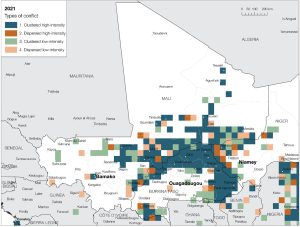
Past jihads were mainly confined to the Sahel
Most of the jihads that have developed in West Africa since the 18th century have been largely contained within the Sahel region (Map 2). In the west, the theocratic movements observed between 1725 and 1797 were rather localised in the Futa Jallon and Futa Toro and did not spread towards the south. In the Central Sahel, as well, the Hamdullahi Caliphate of Sheikhou Ahmadu (also known as Seeku Amadu and Shaykh Ahmad Lobbo), or Macina empire, was a purely Sahelian entity, centred on the Niger Inner Delta in today’s Mali. Only the jihad launched by Usman Dan Fodio in 1804 managed to spread much beyond its original capital region, reaching Ilorin in the south and Adamawa in the east, and overspilling the boundaries of present-day Nigeria to the west and east.
The Sokoto Caliphate created by Dan Fodio, however, was noticeably different from the insurgencies inspired by Al Qaeda and the Islamic State in today’s Sahel. The Caliphate was a decentralised confederation of emirates that relied on slavery and a dedicated bureaucracy in Sokoto. Dan Fodio’s scholarly credentials (and those of his brother Abdullahi and his son Muhammad Bello) were also highly regarded in the region, which is hardly the case for many 21st-century jihadist leaders, and contributes to enhancing the historical legitimacy of the Caliphate.
Map 2. Main jihad areas in West Africa, 1725-1898
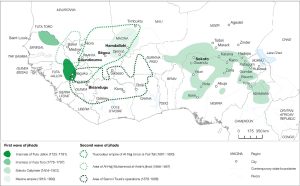
The wave of jihads launched in reaction to colonisation during the second half of the 19th century was also principally waged within the Sahel and its southern peripheries. The Toucouleur empire of Al-Hajj Umar Tall extended from Timbuktu in the north to the Futa Jallon in today’s Guinea. Further west, Al-Hajj Muhamad al-Amin’s uprising against the French was largely confined to the Tambacounda region in today’s Senegal. Samori Touré’s Wassoulou empire briefly expanded south into northern Ghana and Ivory Coast from its stronghold in the Guinean Highlands.
More recently, the Boko Haram insurgency has largely failed to expand south of the Lake Chad region, aside from intermittent attacks in the Middle Belt and reports of negotiations between Boko Haram offshoots and bandits in the northwest. While the group has historically tried to seek legitimacy from the Sokoto Caliphate created by the Fulani Dan Fodio, their leaders and members are predominantly Kanuri, operating in the areas of the former Kanem-Borno Empire, east of Sokoto. Some scholars have treated Boko Haram and other contemporary jihadist movements as echoes of past jihad movements (or slave-raiders and warlords, such as the late 19th-century figure Rabih al-Zubayr), yet the 19th-century jihad leaders operated in a fundamentally different context than the jihadists of today.
Jihadist expansion in northern coastal countries
While past jihads never reached the shores of the Gulf of Guinea, this historical reality hardly suggests that there is an enduring and separate “jihad zone” that cannot truly affect modern coastal states for two important reasons.
First, relying on an overly deterministic explanation of the geographic limits of past jihads goes against everything we know about the spatial mobility and social fluidity of the region. Social groups have developed extensive networks that transcend climatic boundaries, connecting the Sahel to the Gulf of Guinea through intense migration flows and trade diasporas. These movements have considerably intensified in the postcolonial era.
Second, the decolonial political context of 21st-century jihadists is one of modern states whose territories span the traditional limits that have distinguished the Gulf of Guinea from the Sahel. Indeed, the lessons from the recent wave of coups in Sahelian states highlights how jihadists need not fully permeate across the entire territory of a state to create an existential crisis that leads to state failure and chaos.
The most vulnerable region to jihadist expansion is the wide belt that extends from the west of Kankan in Guinea to Parakou in Benin. This vast periphery has few cities and relatively low densities of population compared to both the Sahel and the Gulf of Guinea (Map 3), a terrain that could potentially be beneficial to an insurgency. The local population is also predominantly Muslim and well connected to the Sahel, both culturally and economically, through numerous border markets and long-distance trade networks.
Map 3. Population distribution in West Africa, 2019
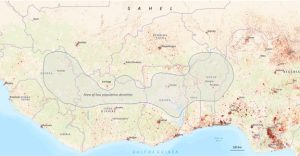
Further, despite its strategic location, the north of coastal countries remains poorly connected to the ports of the Gulf of Guinea. Investment in the transportation, education and health sectors, for example, have historically been much lower than in the densely populated south. If instrumentalised by jihadists, this lack of national integration between the north and south of coastal countries could become a threat to national security, especially if local stigmatisation pushes some Salafis and Fulani into jihadist arms, as observed in the Liptako Gourma today.
How far south can they go?
Several factors could make the progression of jihadist groups more difficult further south, starting with the necessity of building local alliances. Jihadist groups are numerically small and almost never able to hold territory. One of their main strengths is the alliances they can establish locally, by persuasion, threat or violence, with local leaders and marginalised communities. The extremists affiliated with Al Qaeda in the Islamic Maghreb who relocated from northern Algeria in the early 2000s developed extensive networks with local tribes in northern Mali, a process that took years and was facilitated by cultural, linguistic and religious affinities across the two “shores” of the Sahara.
It is uncertain how this could be replicated along the Gulf of Guinea, a region that is vastly different from the Sahel from a linguistic and religious perspective. As jihadist groups move south, they will most likely lose much of their ability to move undetected within the local population. Even in areas with a high share of Muslim population, ethno-cultural connections are not easily undone by jihadi rhetoric and propaganda. South of the Sahel, it is not uncommon to have families or larger groups where Christian and Muslim identities are mixed. Establishing durable bases and getting the support of villagers in regions that are predominantly Christian will remain an even more formidable challenge.
In the southern region of coastal countries, the most likely scenario is a diffuse presence of isolated groups, involved in hit-and-run attacks against poorly defended civilians, rather than steady territorial expansion, as currently observed in the Sahel. As in Burkina Faso and Mali today, this scenario would lead jihadists to expand south rurally without consolidating any serious urban areas and progressively contribute to forming a patchwork insurgency across the whole region, rather than a single zone of Sahelian dominance with outposts on the coast.
How should governments respond?
Perhaps the most decisive factor that determines whether jihadist groups can and will move south is the government response. Transnational groups tend to be more successful when government forces lack the political will and military capabilities to counter them. Coastal countries are comparatively more capable of countering insurgents militarily than Sahelian countries and, perhaps more importantly, more convinced of the necessity to react quickly when attacks are conducted on their territory. They have had a decade to witness the disastrous consequences of Sahelian insurgencies moving towards them and established the foundations of a co-ordinated response to transnational terrorism, through the Accra Initiative and the Integrated Border Stability Mechanism (IBSM) for West Africa, soon to be launched in Abidjan.
Ultimately, the expansion of jihadist groups deep in the south will depend on the timely and appropriate set of initiatives taken by coastal countries. Insurgencies are won when the counterinsurgency force implements “good practices”; for instance, avoiding collateral damages while avoiding adverse practices, such as creating new grievances by painting local conflicts as extremism violence. The past decade has shown that too few of these lessons were implemented in the Sahel, where military strategies have often dominated development initiatives. As the Côte d’Ivoire example suggests, balancing military and social responses may be the very first step to adopt along the Gulf of Guinea to prevent, and possibly contain, violent extremism.
Disclaimer: the views expressed in this manuscript are those of the authors and do not necessarily reflect the official policy or position of the US Air Force Academy, the Air Force, the Department of Defense or the US Government.
Acknowledgments: the authors thank Matthew Pflaum for his useful comments.

